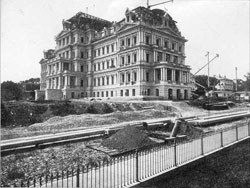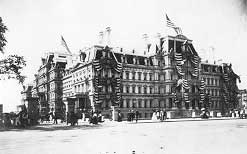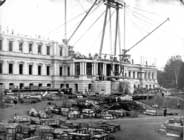Next door to the White House, the Eisenhower Executive Office Building (EEOB)
commands a unique position in both our national history and architectural heritage.
Designed by Supervising Architect of the Treasury, Alfred B. Mullett, it was built
from 1871 to 1888 to house the growing staffs of the State, War, and Navy Departments,
and is considered one of the best examples of French Second Empire architecture
in the country. In bold contrast to many of the somber classical revival buildings
in Washington, the EEOB's flamboyant style epitomizes the optimism and exuberance
of the post-Civil War period.
The State, War, and Navy Building, as it was originally known, housed the three Executive
Branch Departments most intimately associated with formulating and conducting the nation's
foreign policy in the last quarter of the nineteenth century and the first quarter of the
twentieth century -- the period when the United States emerged as an international power.
The building has housed some of the nation's most significant diplomats and politicians
and has been the scene of many historic events.
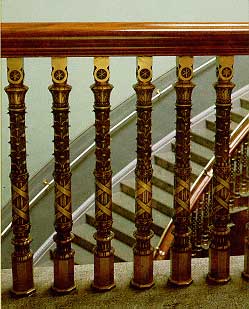
Bronze stair balusters for the State Department, south wing. Walter Smalling, Jr.
The history of the EEOB began long before its foundations were laid. The first executive
offices were constructed on sites flanking the White House between 1799 and 1820. A series
of fires (including the burning by the British in 1814) and overcrowded conditions led to
the construction of the existing Treasury Building, and in 1866, the construction of the
North Wing of the Treasury Building necessitated the demolition of the State Department
building to the northeast of the White House. The State Department then moved to the D.C.
Orphan Asylum Building while the War and Navy Departments continued to make do with their cramped
quarters to the west of the White House.
In December of 1869, Congress appointed a commission to select a site and prepare plans and
cost estimates for a new State Department Building. The commission was also to consider
possible arrangements for the War and Navy Departments. To the horror of some who expected
a Greek Revival twin of the Treasury Building to be erected on the other side of the White
House, the elaborate French Second Empire style design by Alfred Mullett
was selected, and construction of a building to house all three departments began in June of 1871.

Detail of mantelpiece from the former office of the Secretary of State.
White House Photo.
Construction took 17 years as the building slowly rose wing by wing. When the
EEOB was finished in 1888, it was the largest office building in Washington,
with nearly
2 miles of black and white tiled corridors. Almost all of the interior detail is of cast
iron or plaster; the use of wood was minimized to insure fire safety.
Eight monumental curving staircases
of granite with over 4,000 individually cast bronze balusters are capped by four skylight
domes and two stained glass rotundas.
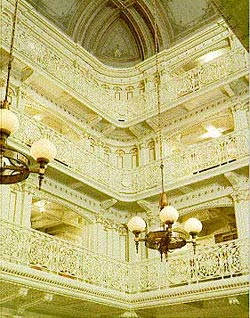
The Executive Office of the President Library was originally the State
Department's Library. This room was constructed entirely of cast iron
in 1875. Walter Smalling, Jr.
Completed in 1875, the State Department's south wing was the first to be
occupied, with its elegant four-story library (completed in 1876), Diplomatic Reception
Room, and Secretary's office decorated with carved wood, Oriental rugs,
and stenciled wall patterns.
The Navy Department moved into the east wing in 1879, where elaborate
wall and ceiling stenciling and marqetry floors decorated the office of
the Secretary. The Indian Treaty Room, originally the Navy's library
and reception room, cost more per square foot than any other room in the
building because of its rich marble wall panels, tiled floors, 800-pound bronze
sconces, and gold leaf ornamentation. This room has been the scene of
many Presidential news conferences and continues to be used for
conferences and receptions attended by the President.
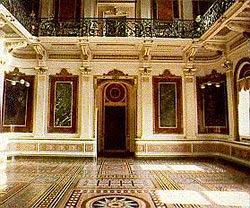
The Indian Treaty Room. This two-story room has seen the signing of international
treaties, press conferences, and presidential ceremonies. The bronze lamps in
each corner represent For Peace Prepare for War, Liberty, Science, and
Industry, 1991. Joyce Naltchayan.
The remaining north, west, and center wings were constructed for the War
Department and took an additional 10 years to build. Notable interiors
include an ornate cast-iron library, the Secretary's suite, and the
stained glass skylight over the west wing's double staircase.
|
